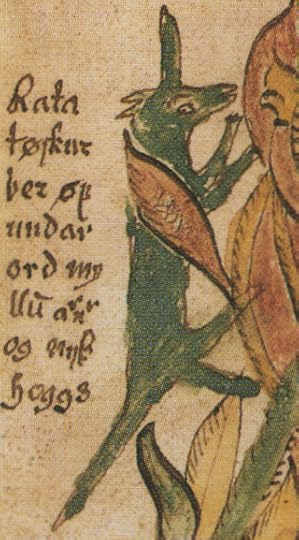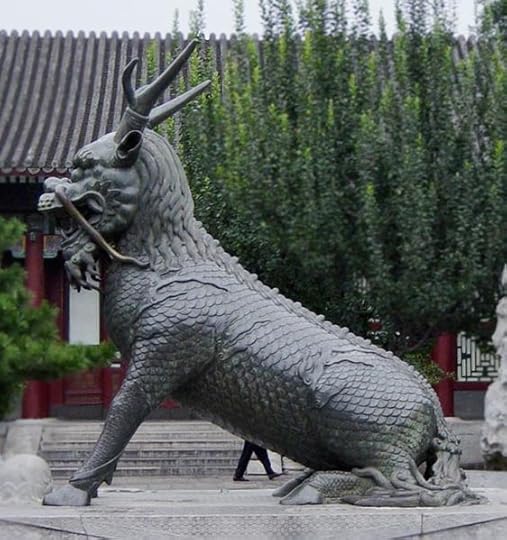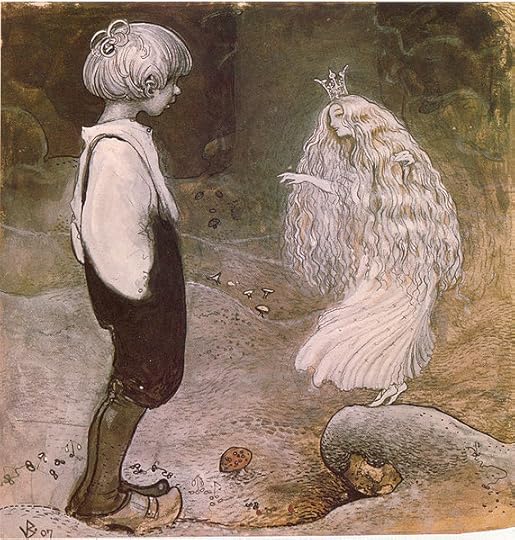Sarah Mäkelä's Blog, page 17
April 23, 2012
U is for Urayuli
Name: Urayuli (means "hairy men")
Type: hairy humanoid
Origin: Native American mythology of southwestern Alaska Description: The Urayuli reside in the forests of southwestern Alaska near Lake Iliamna. They supposedly stand 10 feet tall and have shaggy fur and glowing eyes. They're thought to make high pitch cries, resembling a loon's. They have very long arms, which reach their ankles. They behave peacefully.
Interesting Facts: They seem to be very Bigfoot/Yeti-like. It's fascinating how many cultures have these kinds of creatures. The Urayuli are thought to be children who were lost in the woods, particularly at night, and transformed into this kind of creature. Probably another tale to make children behave.
What other "U" beings do you know of?
Type: hairy humanoid
Origin: Native American mythology of southwestern Alaska Description: The Urayuli reside in the forests of southwestern Alaska near Lake Iliamna. They supposedly stand 10 feet tall and have shaggy fur and glowing eyes. They're thought to make high pitch cries, resembling a loon's. They have very long arms, which reach their ankles. They behave peacefully.
Interesting Facts: They seem to be very Bigfoot/Yeti-like. It's fascinating how many cultures have these kinds of creatures. The Urayuli are thought to be children who were lost in the woods, particularly at night, and transformed into this kind of creature. Probably another tale to make children behave.
What other "U" beings do you know of?
Published on April 23, 2012 21:00
T is for Tizheruk / Hunky Hero Wrap-up
I had quite a busy weekend, but I'm all caught up with my A to Z Challenge posts now. Check out "S" here. Also, I had a fun interview that posted yesterday at Dawn's Reading Nook.
Finally, I have some news on the giveaway that had been going on this past week. Congratulations to Evita's Reads and Filia Oktarina! I chose two winners for the prize since I had such an amazing turnout of 245 entries! Thanks everyone for entering!
Name: Tizheruk (Also known as Pal-Rai-Yûk)
Type: sea creature
Origin: Inuit mythology
Description: Large snake-like sea creature, which lives near the coast of an Alaska island. It's approximately seven feet long with an alligator-like head, six legs, and a flipper on its tail. The Tizheruk snatches people off piers and boats.
Interesting Facts: Other sea monsters inhabit nearby Canadian waters, the Ogopogo (or Naitaka of the Okanakanes) and the Haietlik of the Nootka. The Ogopogo is believed to live in Okanagan Lake, and the Haietlik is a "Lightning Snake" that shoots lightning from its tongue.
What "T" beings or creatures do you know about?
Finally, I have some news on the giveaway that had been going on this past week. Congratulations to Evita's Reads and Filia Oktarina! I chose two winners for the prize since I had such an amazing turnout of 245 entries! Thanks everyone for entering!
Name: Tizheruk (Also known as Pal-Rai-Yûk)
Type: sea creature
Origin: Inuit mythology
Description: Large snake-like sea creature, which lives near the coast of an Alaska island. It's approximately seven feet long with an alligator-like head, six legs, and a flipper on its tail. The Tizheruk snatches people off piers and boats.
Interesting Facts: Other sea monsters inhabit nearby Canadian waters, the Ogopogo (or Naitaka of the Okanakanes) and the Haietlik of the Nootka. The Ogopogo is believed to live in Okanagan Lake, and the Haietlik is a "Lightning Snake" that shoots lightning from its tongue.
What "T" beings or creatures do you know about?
Published on April 23, 2012 03:00
April 20, 2012
S is for Stymphalian birds
Name: Stymphalian birds
Type: birds
Origin: Greek mythology
Description: Man-eating birds who have bronze beaks and sharp metallic feathers, which they throw at their victims. Also, their feces is quite toxic. Their name comes from the fact that they live near Lake Stymphalia in Arcadia. They're sacred to the god of war, Ares.
Interesting Facts: The Stymphalian birds were Herucles's sixth task in The Twelve Labours of Herucles. He scared the birds by shaking a rattle made by Hephaestus for the purpose and given to him by Athena. He shot some with arrows to complete the Labour.
What "S" creatures or beings do you know about?
Type: birds
Origin: Greek mythology
Description: Man-eating birds who have bronze beaks and sharp metallic feathers, which they throw at their victims. Also, their feces is quite toxic. Their name comes from the fact that they live near Lake Stymphalia in Arcadia. They're sacred to the god of war, Ares.
Interesting Facts: The Stymphalian birds were Herucles's sixth task in The Twelve Labours of Herucles. He scared the birds by shaking a rattle made by Hephaestus for the purpose and given to him by Athena. He shot some with arrows to complete the Labour.
What "S" creatures or beings do you know about?
Published on April 20, 2012 21:00
R is for Ratatoskr
 Ratatoskr in a 17th century
Ratatoskr in a 17th century Icelandic manuscript.Name: Ratatoskr (Typically means "drill-tooth" or "bore-tooth," although some say based off its etymology that it'd be more like rata-/rati- for "the traveler" and -toskr for "tusk." Basically "the climber tusk" or "tusk the traveler.")
Type: nature spirit
Origin: Norse mythology
Description: Ratatoskr is... a squirrel. *grins* He climbs up and down Yggdrasil, the world tree, to take messages between the unnamed eagle at the top and the wyrm Níðhöggr who lives under one of the tree roots at the bottom. According to the 16th chapter of Prose Edda's Gylfaginning, Ratatoskr "runs up and down the ash. He tells slanderous gossip, provoking the eagle and Níðhöggr." Some say the fact Ratatoskr is portrayed as a lowly squirrel is due to his behavior in stirring up trouble.
Interesting Facts: He can be found in both the Poetic Edda, which is a compilation of Old Norse poems and a very important source of information about Norse mythology, as well as Prose Edda, which was written by Snorri Sturluson in approximately 1220. The Prose Edda contains eddic and skaldic poetry poetry about Norse mythology. For such a small creature, there's a lot of different theories on both his name and purpose/role in Norse mythology.
Have you heard of Ratatoskr before? Any "R" creatures or beings you know of?
Published on April 20, 2012 01:27
April 18, 2012
Q is for Qilin
 A qilin of the Qing dynasty in
A qilin of the Qing dynasty inBeijing's Summer PalaceName: Qilin
Type: Chinese chimera
Origin: Chinese mythology
Description: The Qilin is a hooved chimera sometimes portrayed as having parts of a fish, dragon, ox, lion and/or even a tiger. They are said to bring prosperity and only appear in land ruled by a peaceful or a wise man. For instance, the birth of Confucius was foretold by arrival of a Qilin.
The Qilin's origins are tied to Chinese exploration of Africa around the 5th century. The Zheng He's exploration of the areas around modern Somalia were successful, and they obtained some giraffes and other animals which they brought back to China. The word Geri, which in Somalia means giraffe, is the base word for Qilin. The slender high figure of the Qilin gave it special properties, such as walking on water and walking in grass without damaging the blades of the grass. The Qilin love the righteous and should anyone evil try to attack them while a Qilin is close by, the Qilin would attack the wicked by shooting flames from its mouth or using other powers.
Interesting Facts: The Chinese have the Qilin as their third most powerful creature after the dragon and the phoenix. This was not always been the case. Before the Qin-dynasty, the Qilin was ranked the highest. In Japan, the Kirin is the same as the Chinese Qilin. The Japanese still honor pre-Qin dynasty mythology and have the Kirin as the top creature in their culture.
What Q creatures or beings do you know of?
Published on April 18, 2012 22:59
P is for Pixie
 Illustration from Among Pixies and
Illustration from Among Pixies and Trolls, a children's anthologyName: Pixie (also Pixy, Pixi, Pizkie, Piskies and Pigsies)
Type: fairy or sprite-like being
Origin: Cornish folklore
Description: Pixies are very small beings that live mostly in the high moorland areas near Devon and Cornwall. They're also associated with exploring ocean caves. Usually, they are naked or scantly clothed and possess pointed ears and a pointed hat. Some say that pixies have wings, and others say they are without wings. One thing they especially enjoy is riding horses. While doing so, they make ringlets in the manes of the horses they ride. As for their demeanor, sometimes they kidnap children or mislead travelers (the cure for being pixie-led is to turn your coat inside out), but they not thought to be malevolent. They've been said to be help out widows and those in need at times.
Interesting Facts: Pixies lore predates Christianity in Britain, and the people in Cornwall and Devon took them quite seriously. To this day, there is a Pixie Day from an old tradition re-enacted annually on the Saturday in June nearest Mid-Summer's Day in Ottery St. Mary, England.
Have you heard of Pixies? Any other "P" beings or creatures you know of?
Published on April 18, 2012 02:55
April 17, 2012
O is for Otso/Orpheus
Hey everyone! A couple bits of news first. Don't forget that I have the Hunky Hero giveaway going on. Also, Captive Moonlight is now on sale at All Romance eBooks (and at a discounted price!).
Anyways, today I'm doing a Finnish mythology being, but I have a tribute to an extra one based in Greek/Roman mythology that I couldn't let slip by.
Name: Otso (also known as Ohto, Kontio, metsän kuningas (the king of the forest), and mesikämmen (honeypaws) my favorite, lol)
Type: bear/nature spirit
Origin: Finnish mythology
Description: The Otso is basically a bear spirit. He's typically called friend, brother, uncle, or forest cousin (read below on its name). In some of the traditions, bears were thought to be relatives who had ran away from the community and were transformed by the forest's power.
Interesting Facts: Despite the long list of terms for it, this spirit wasn't properly named since the Finns did everything they could to avoid directly referring to it due to it being that sacred to them. They even have a ritual called Peijainen for if a bear was killed. There would be mourners and wailers for it. The bear's skull, which is where the bear's spirit resided, would be placed in a sacred clearing and taken care of and given gifts.
Now to the extra credit: Orpheus. He was a legendary musician, poet, and prophet in Greek mythology. His ability to play music and sing was seen as almost divine, and it charmed or entranced. His music even overrode that of the Sirens who were known for their bewitching voices.
There's some controversy over whether he was a coward or not (ahem, because he had caused the gods to allow him to go to the Underworld to try to bring Eurydice, his wife who died by snake bite after being chased by a satyr, back instead of... dying so he could be in Hades with her *rolls eyes*). They think he wasn't truly in love with her for that, and therefore that the gods had punished him and only gave him an apparition of his wife in the Underworld.
Regardless of all that, I enjoy picturing Orpheus as this guy someone caring and... err... attractive. ;-) Maybe it's the romantic in me. Here's Eurydice by Sleepthief. I've listened to this song so many times, and it's absolutely beautiful and romantic, even if it's also sad.
Tell me what you think! Also, can you name any other O beings or creatures?

Anyways, today I'm doing a Finnish mythology being, but I have a tribute to an extra one based in Greek/Roman mythology that I couldn't let slip by.
Name: Otso (also known as Ohto, Kontio, metsän kuningas (the king of the forest), and mesikämmen (honeypaws) my favorite, lol)
Type: bear/nature spirit
Origin: Finnish mythology
Description: The Otso is basically a bear spirit. He's typically called friend, brother, uncle, or forest cousin (read below on its name). In some of the traditions, bears were thought to be relatives who had ran away from the community and were transformed by the forest's power.
Interesting Facts: Despite the long list of terms for it, this spirit wasn't properly named since the Finns did everything they could to avoid directly referring to it due to it being that sacred to them. They even have a ritual called Peijainen for if a bear was killed. There would be mourners and wailers for it. The bear's skull, which is where the bear's spirit resided, would be placed in a sacred clearing and taken care of and given gifts.
Now to the extra credit: Orpheus. He was a legendary musician, poet, and prophet in Greek mythology. His ability to play music and sing was seen as almost divine, and it charmed or entranced. His music even overrode that of the Sirens who were known for their bewitching voices.
There's some controversy over whether he was a coward or not (ahem, because he had caused the gods to allow him to go to the Underworld to try to bring Eurydice, his wife who died by snake bite after being chased by a satyr, back instead of... dying so he could be in Hades with her *rolls eyes*). They think he wasn't truly in love with her for that, and therefore that the gods had punished him and only gave him an apparition of his wife in the Underworld.
Regardless of all that, I enjoy picturing Orpheus as this guy someone caring and... err... attractive. ;-) Maybe it's the romantic in me. Here's Eurydice by Sleepthief. I've listened to this song so many times, and it's absolutely beautiful and romantic, even if it's also sad.
Tell me what you think! Also, can you name any other O beings or creatures?
Published on April 17, 2012 03:41
April 16, 2012
Yummy Hunky Heroes BlogHop
I hate doing multiple posts in one day, but I'm going to have to make an exception today. I've got the Hunky Hero Blog Hop going on as well as today's A to Z Challenge. Check that out too, if you have a chance! :-)
Now for the Hunky Hero Blog Hop!

In celebration of hot hunky heroes, I'm doing a giveaway of one ebook from my backlist.
Aside from the heroes in my books, because they're all hunky heroes *grins*, I'll tell you about some of my favorite hunky men. One of them is David Beckham. Yum!!
[image error]
As for books, I adore two men above the rest. Pritkin from Karen Chance's Cassie Palmer series and Curran from Ilona Andrews's Kate Daniels series. Those two are so swoon worthy!
Who are your favorite hunky heroes? :-)
a Rafflecopter giveaway
<a href="http://rafl.es/enable-js"&am... need javascript enabled to see this giveaway</a>.
Visit the other bloggers participating in the hop.

Now for the Hunky Hero Blog Hop!

In celebration of hot hunky heroes, I'm doing a giveaway of one ebook from my backlist.
Aside from the heroes in my books, because they're all hunky heroes *grins*, I'll tell you about some of my favorite hunky men. One of them is David Beckham. Yum!!
[image error]
As for books, I adore two men above the rest. Pritkin from Karen Chance's Cassie Palmer series and Curran from Ilona Andrews's Kate Daniels series. Those two are so swoon worthy!
Who are your favorite hunky heroes? :-)
a Rafflecopter giveaway
<a href="http://rafl.es/enable-js"&am... need javascript enabled to see this giveaway</a>.
Visit the other bloggers participating in the hop.
Published on April 16, 2012 03:05
N is for Nereid
Here is today's A to Z Challenge post. It's is a quickie since I'm also doing the Hunky Hero BlogHop today.
Name: Nereid
Type: sea nymph
Origin: Greek mythology
Description: The Nereids are the fifty daughters of Nereus and Doris and sisters to Nerites. They are sea nymphs and often accompany Poseidon. Their demeanor is friendly, and they help sailors who are fighting dangerous storms. They live in and are associated with the Aegean Sea.
Interesting Facts: One of the moons of Neptune is named Nereid after them since they were attendants of Neptune (Poseidon in Greek mythology). Notable Nereids are Thetis, the mother of Achilles, and Amphitrite, wife of Poseidon.
Have you heard of the Nereids? Are there any N beings or creatures you know of?
Name: Nereid
Type: sea nymph
Origin: Greek mythology
Description: The Nereids are the fifty daughters of Nereus and Doris and sisters to Nerites. They are sea nymphs and often accompany Poseidon. Their demeanor is friendly, and they help sailors who are fighting dangerous storms. They live in and are associated with the Aegean Sea.
Interesting Facts: One of the moons of Neptune is named Nereid after them since they were attendants of Neptune (Poseidon in Greek mythology). Notable Nereids are Thetis, the mother of Achilles, and Amphitrite, wife of Poseidon.
Have you heard of the Nereids? Are there any N beings or creatures you know of?
Published on April 16, 2012 02:17
April 14, 2012
M is for Minotaur
Today's the last day for the Giveaway from the Castle Vault at Castles & Guns! Make sure to stop by and enter.
Name: Minotaur (means the "Bull of Minos")
Type: human hybrid
Origin: Greek mythology
Description: The Minotaur has the head of a bull and the body of a man. His parents are the Cretan Bull and Pasiphaë. Pasiphaë was married to King Minos of Crete, but after King Minos had prayed to Poseidon and received support from him, he was supposed to kill the Cretan Bull. He thought it was so beautiful that he couldn't, so he sacrificed one of his own bulls. For his punishment, Pasiphaë fell in love with the Cretan Bull and had the architect Daedalus build a hollow wooden cow so she could mate with the bull. Minotaur was nursed by his mother until he became fierce and began devouring men. He lives at the center of the Cretan Labyrinth, which was constructed by Daedalus and his son by command of King Minos of Crete.
Interesting Facts: One of the future Athenian king Theseus's acts which helped him to secure his throne was to slay the Minotaur. Also, since some sources don't specify which end is part bull and which is part human, sometimes the Minotaur has a bull's lower half and a human torso.
Have you heard of the Minotaur before? Any other creatures or beings you can think of that begin with M?
Name: Minotaur (means the "Bull of Minos")
Type: human hybrid
Origin: Greek mythology
Description: The Minotaur has the head of a bull and the body of a man. His parents are the Cretan Bull and Pasiphaë. Pasiphaë was married to King Minos of Crete, but after King Minos had prayed to Poseidon and received support from him, he was supposed to kill the Cretan Bull. He thought it was so beautiful that he couldn't, so he sacrificed one of his own bulls. For his punishment, Pasiphaë fell in love with the Cretan Bull and had the architect Daedalus build a hollow wooden cow so she could mate with the bull. Minotaur was nursed by his mother until he became fierce and began devouring men. He lives at the center of the Cretan Labyrinth, which was constructed by Daedalus and his son by command of King Minos of Crete.
Interesting Facts: One of the future Athenian king Theseus's acts which helped him to secure his throne was to slay the Minotaur. Also, since some sources don't specify which end is part bull and which is part human, sometimes the Minotaur has a bull's lower half and a human torso.
Have you heard of the Minotaur before? Any other creatures or beings you can think of that begin with M?
Published on April 14, 2012 15:26



